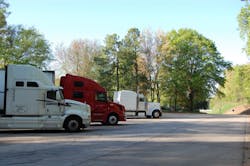Regulations poised to reduce driver ranks and trucking productivity
The trucking industry is going to suffer a significant productivity hit from a variety current and on-the-horizon regulatory initiatives, with those same initiatives expected to cause a substantial “wash-out” within the truck driver labor pool as well.
In a conference call hosted by Stifel Financial Corp., Gordon Klemp – founder and president of the National Transportation Institute (NTI) – and Leah Shaver, NTI’s COO, said that while “regulatory drag” is an issue that’s “been around for a long time,” it’s impact on the industry is about to be felt acutely.
“ELDs [electronic logging devices] are here and speed limiters are on the horizon, with hair testing [for drug use] tending to grow in use,” said Klemp.
He interviewed fleets that implemented ELDs and said “they saw a 10% to 15% crunch on productivity almost instantly, though that is now down to 5%.”
The reason for the front-end productivity losses is that drivers initially don’t know how to use them properly while motor carriers spend time sorting out how to manage the technology and data as well.
“When we see them [ELDs] roll through industry, I think we’ll settle out to a 5% net loss in productivity,” Klemp noted.
The oft-delayed speed limiter rule will cost the industry another 3% to 5% in productivity, though that will vary quite a bit among fleets, which could be a problem.“With hair testing, everyone we talk with says the same thing – it’s painful to start with,” Klemp noted. “They went from 5% to 8% rejection rates [for driver candidates testing positive in urine-based drug tests] to an 11.6% rejection rate. But then it dropped back down to 5%.”
One reason for that drop, Klemp speculated, is that candidates “self-select” themselves out. “But that [11.6% rejection rate] is higher than I would have ever thought and it will lower the labor pool by 5%.”
Add it all up and the industry is facing a 15% loss in productivity due to regulatory drag, “and it’s probably more when you look at the whole boat [of regulations] and not just the three we picked out,” Klemp stressed.
NTI’s Shaver, who previously worked for a largest Midwestern-based TL carrier for 14 years, added that early retirements and drivers “wearing out” from the physical demands of the job are becoming bigger problems as well.
“The industry workforce is peaking at the high end of age, and that’s not what we want in a tough job like truck driving,” she said. Right now, the largest cohort of the truck driving workforce – some 34.3% – is aged 45 to 54, with the second largest cohort aged 35 to 44 at 31.8% and 55 to 64 at 13.9%.
“Ultimately we know age is a problem right now and it will continue to be an issue,” Shaver stressed. “We are not recruiting our children and grandchildren to do this job. No longer want our children to work this hard and be away from home so much.”
Klemp added that ELDs are exacerbating the problem to a degree and many older drivers may simply quit rather than adapt to the new technology.
“We estimate that about a third of the 16% of drivers at or near retirement age might leave. Overall that’s 5% of the driver workforce,” he explained. “And it’s probably closer to 8% when you factor in many drivers not wanting ‘Big Brother’ in the cab.”
Klemp noted that most drivers that use the technology for 30 days end up liking it once they get used to it, but it’s getting drivers to stick with it that long that could be problematic from a workforce retention perspective.
“Many may go to carriers that are not using them, but by 2017, everyone must use them, so that option is running out,” he said.
About the Author
Sean Kilcarr
Editor in Chief
Sean Kilcarr is a former longtime FleetOwner senior editor who wrote for the publication from 2000 to 2018. He served as editor-in-chief from 2017 to 2018.

